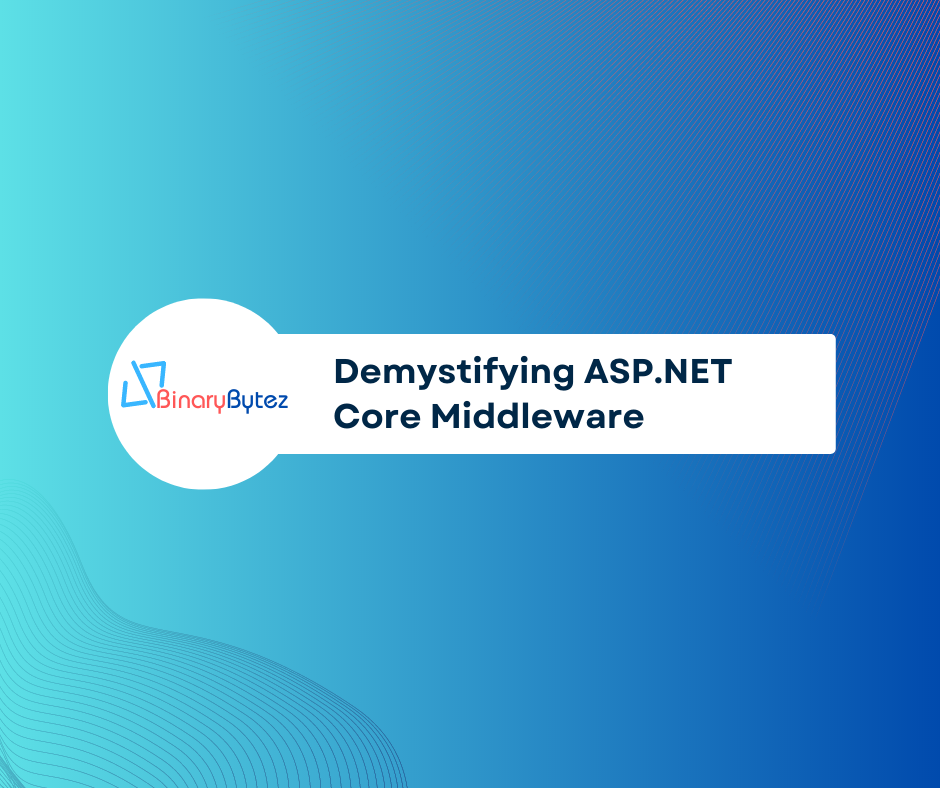Middleware is a crucial component that sits between the server and the application, allowing you to handle incoming HTTP requests and outgoing responses.
A Guide to Handling Requests and Responses
ASP.NET Core is a powerful and flexible framework for building web applications, and one of its key features is Middleware. Middleware is a crucial component that sits between the server and the application, allowing you to handle incoming HTTP requests and outgoing responses. In this blog post, we will demystify ASP.NET Core Middleware and explore how it enables you to add custom logic, modify requests, and process responses.
What is Middleware?
In ASP.NET Core, Middleware is a pipeline-based request processing mechanism. Each Middleware component in the pipeline can examine, modify, or delegate the processing of an HTTP request. The request then flows through the pipeline, passing through each Middleware, until it reaches the application or gets a response.
Middleware components are executed in the order they are added to the pipeline, and they work together to handle various tasks such as authentication, logging, routing, and caching. The ability to chain multiple Middlewares gives developers the flexibility to compose complex request handling logic efficiently.
Middleware Components
Middleware components are simple classes or functions that conform to the Middleware signature. A Middleware component has access to the HttpContext, which contains the incoming request and the outgoing response.
Here’s the signature of a Middleware component:
public delegate Task RequestDelegate(HttpContext context);
A Middleware component is a delegate that takes an HttpContext as a parameter and returns a Task. The delegate can handle the incoming request, optionally modify it, and pass it along to the next Middleware or the application itself.
Implementing Custom Middleware
Creating custom Middleware is straightforward. You can add a custom Middleware component to the pipeline using the UseMiddleware extension method in the Startup class’s Configure method.
Let’s create a simple custom Middleware that logs information about incoming requests:
public class RequestLoggerMiddleware
{
private readonly RequestDelegate _next;
public RequestLoggerMiddleware(RequestDelegate next)
{
_next = next;
}
public async Task Invoke(HttpContext context)
{
// Log information about the incoming request
var requestPath = context.Request.Path;
var requestMethod = context.Request.Method;
Console.WriteLine($"Incoming request: {requestMethod} {requestPath}");
// Call the next Middleware in the pipeline
await _next(context);
// Middleware code to execute after the request has been handled
}
}
In the example above, our custom Middleware, RequestLoggerMiddleware, logs information about the incoming request and then calls the next Middleware in the pipeline using the _next delegate.
To add the custom Middleware to the pipeline, update the Configure method in the Startup class:
public void Configure(IApplicationBuilder app)
{
app.UseMiddleware<RequestLoggerMiddleware>();
// Other Middlewares and application configuration
}
Now, whenever a request is made to your application, the RequestLoggerMiddleware will log information about the incoming request.
Ordering Middleware Components
The order of Middleware components matters, as each Middleware can influence the behavior of subsequent components. For example, if authentication Middleware is added before routing Middleware, authentication will be performed before routing the request to the appropriate controller action.
To control the order of Middleware execution, you can use the Use and Run extension methods. The Use method adds the Middleware to the pipeline, while the Run method adds a terminal Middleware that doesn’t call the next Middleware.
app.UseMiddleware<AuthenticationMiddleware>();
app.UseMiddleware<RequestLoggerMiddleware>();
app.UseMiddleware<RoutingMiddleware>();
app.Run(async context =>
{
// Terminal Middleware for handling requests without calling the next Middleware.
await context.Response.WriteAsync("Page not found.");
});
In the example above, AuthenticationMiddleware, RequestLoggerMiddleware, and RoutingMiddleware are executed in sequence, while the Run method provides a terminal Middleware to handle requests that don’t match any route.
Conclusion
ASP.NET Core Middleware is a powerful and flexible feature that enables developers to handle HTTP requests and responses in a modular and extensible manner. By creating custom Middleware components, you can add custom logic, modify requests, and process responses to build robust and feature-rich web applications. Understanding how Middleware works and its order of execution is essential for building efficient and well-organized ASP.NET Core applications.
In this blog post, I’ve explored the concept of ASP.NET Core Middleware, implemented a custom Middleware, and learned how to control the order of Middleware execution. Armed with this knowledge, you can enhance your ASP.NET Core projects with custom Middleware to handle various tasks efficiently and provide a seamless user experience.
Please find original article here, Demystifying ASP.NET Core Middleware.
Notice Inappropriate?
If you come across any inappropriate content, please report it to our administrators!





